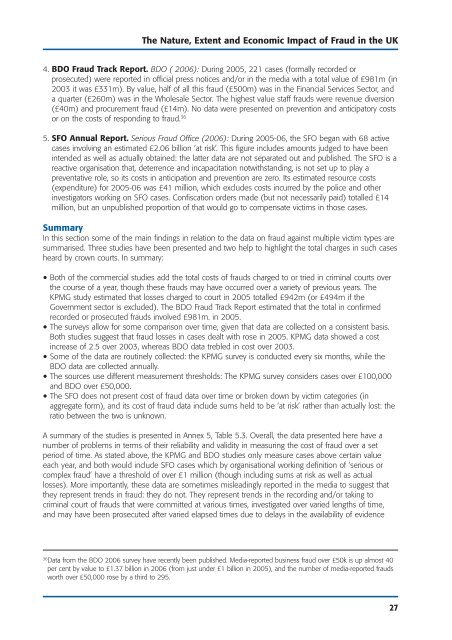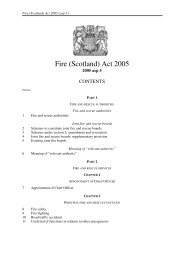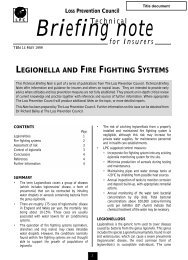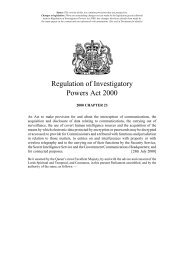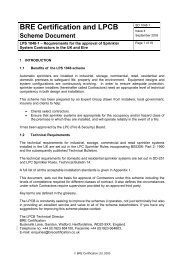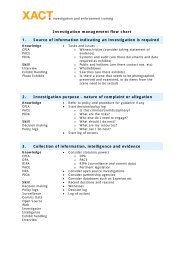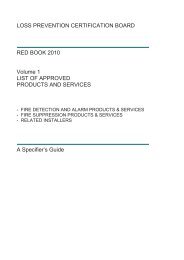The Nature, Extent and Economic Impact of ... - Cardiff University
The Nature, Extent and Economic Impact of ... - Cardiff University
The Nature, Extent and Economic Impact of ... - Cardiff University
Create successful ePaper yourself
Turn your PDF publications into a flip-book with our unique Google optimized e-Paper software.
<strong>The</strong> <strong>Nature</strong>, <strong>Extent</strong> <strong>and</strong> <strong>Economic</strong> <strong>Impact</strong> <strong>of</strong> Fraud in the UK<br />
4. BDO Fraud Track Report. BDO ( 2006): During 2005, 221 cases (formally recorded or<br />
prosecuted) were reported in <strong>of</strong>ficial press notices <strong>and</strong>/or in the media with a total value <strong>of</strong> £981m (in<br />
2003 it was £331m). By value, half <strong>of</strong> all this fraud (£500m) was in the Financial Services Sector, <strong>and</strong><br />
a quarter (£260m) was in the Wholesale Sector. <strong>The</strong> highest value staff frauds were revenue diversion<br />
(£40m) <strong>and</strong> procurement fraud (£14m). No data were presented on prevention <strong>and</strong> anticipatory costs<br />
or on the costs <strong>of</strong> responding to fraud. 36<br />
5. SFO Annual Report. Serious Fraud Office (2006): During 2005-06, the SFO began with 68 active<br />
cases involving an estimated £2.06 billion ‘at risk’. This figure includes amounts judged to have been<br />
intended as well as actually obtained: the latter data are not separated out <strong>and</strong> published. <strong>The</strong> SFO is a<br />
reactive organisation that, deterrence <strong>and</strong> incapacitation notwithst<strong>and</strong>ing, is not set up to play a<br />
preventative role, so its costs in anticipation <strong>and</strong> prevention are zero. Its estimated resource costs<br />
(expenditure) for 2005-06 was £41 million, which excludes costs incurred by the police <strong>and</strong> other<br />
investigators working on SFO cases. Confiscation orders made (but not necessarily paid) totalled £14<br />
million, but an unpublished proportion <strong>of</strong> that would go to compensate victims in those cases.<br />
Summary<br />
In this section some <strong>of</strong> the main findings in relation to the data on fraud against multiple victim types are<br />
summarised. Three studies have been presented <strong>and</strong> two help to highlight the total charges in such cases<br />
heard by crown courts. In summary:<br />
5 Both <strong>of</strong> the commercial studies add the total costs <strong>of</strong> frauds charged to or tried in criminal courts over<br />
the course <strong>of</strong> a year, though these frauds may have occurred over a variety <strong>of</strong> previous years. <strong>The</strong><br />
KPMG study estimated that losses charged to court in 2005 totalled £942m (or £494m if the<br />
Government sector is excluded). <strong>The</strong> BDO Fraud Track Report estimated that the total in confirmed<br />
recorded or prosecuted frauds involved £981m. in 2005.<br />
5 <strong>The</strong> surveys allow for some comparison over time, given that data are collected on a consistent basis.<br />
Both studies suggest that fraud losses in cases dealt with rose in 2005. KPMG data showed a cost<br />
increase <strong>of</strong> 2.5 over 2003, whereas BDO data trebled in cost over 2003.<br />
5 Some <strong>of</strong> the data are routinely collected: the KPMG survey is conducted every six months, while the<br />
BDO data are collected annually.<br />
5 <strong>The</strong> sources use different measurement thresholds: <strong>The</strong> KPMG survey considers cases over £100,000<br />
<strong>and</strong> BDO over £50,000.<br />
5 <strong>The</strong> SFO does not present cost <strong>of</strong> fraud data over time or broken down by victim categories (in<br />
aggregate form), <strong>and</strong> its cost <strong>of</strong> fraud data include sums held to be ‘at risk’ rather than actually lost: the<br />
ratio between the two is unknown.<br />
A summary <strong>of</strong> the studies is presented in Annex 5, Table 5.3. Overall, the data presented here have a<br />
number <strong>of</strong> problems in terms <strong>of</strong> their reliability <strong>and</strong> validity in measuring the cost <strong>of</strong> fraud over a set<br />
period <strong>of</strong> time. As stated above, the KPMG <strong>and</strong> BDO studies only measure cases above certain value<br />
each year, <strong>and</strong> both would include SFO cases which by organisational working definition <strong>of</strong> ‘serious or<br />
complex fraud’ have a threshold <strong>of</strong> over £1 million (though including sums at risk as well as actual<br />
losses). More importantly, these data are sometimes misleadingly reported in the media to suggest that<br />
they represent trends in fraud: they do not. <strong>The</strong>y represent trends in the recording <strong>and</strong>/or taking to<br />
criminal court <strong>of</strong> frauds that were committed at various times, investigated over varied lengths <strong>of</strong> time,<br />
<strong>and</strong> may have been prosecuted after varied elapsed times due to delays in the availability <strong>of</strong> evidence<br />
36<br />
Data from the BDO 2006 survey have recently been published. Media-reported business fraud over £50k is up almost 40<br />
per cent by value to £1.37 billion in 2006 (from just under £1 billion in 2005), <strong>and</strong> the number <strong>of</strong> media-reported frauds<br />
worth over £50,000 rose by a third to 295.<br />
27


